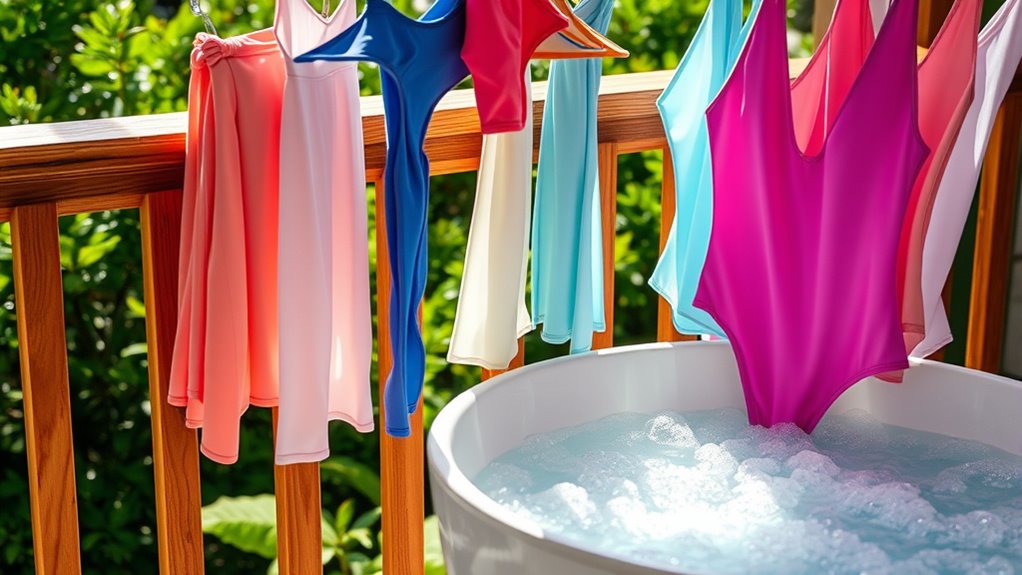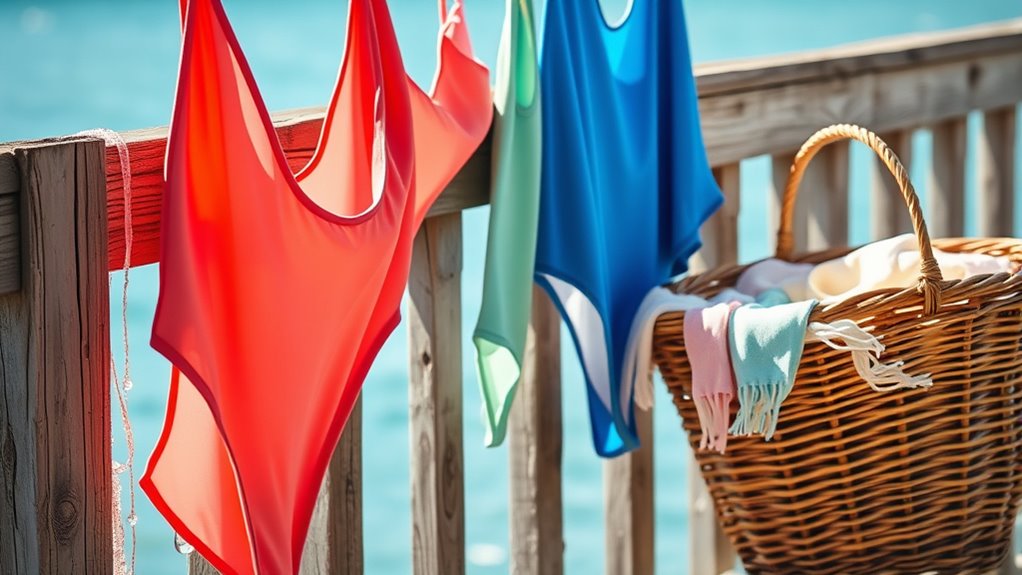To maintain your swimwear, rinse it immediately after use to remove chlorine and salt. Hand wash with cool water and a gentle detergent, avoiding wringing. If using a machine, place your swimwear in a mesh bag and select a gentle cycle. Always air dry by laying flat or hanging in the shade. Keep out of direct sunlight to preserve color and elasticity. Follow these tips, and you’ll find more ways to care for your swimwear effectively.
Key Takeaways
- Rinse swimwear immediately after use with cool water to remove chlorine and salt, preserving fabric integrity.
- Hand wash swimwear in a basin with cool water and gentle detergent, avoiding wringing to prevent stretching.
- For machine washing, use a mesh bag on a gentle cycle with cold water, and skip fabric softener to protect quality.
- Air dry swimwear by laying it flat on a towel or hanging in the shade, avoiding direct sunlight and heat.
- Regular care, including rinsing and proper washing, extends the lifespan and vibrancy of your swimsuit.

Swimwear is an essential part of your summer wardrobe, but keeping it in great shape requires a little effort. Whether you’re hitting the beach or lounging by the pool, your swimwear endures a lot. Chlorine, saltwater, and sun exposure can take a toll on your favorite swimsuits, but with the right washing and drying techniques, you can extend their lifespan.
First, it’s *vital* to rinse your swimwear immediately after each use. Even if you’ve been swimming in a chlorinated pool, just a quick rinse under cool water can help wash away harmful chemicals that break down fabric over time. This simple habit helps maintain the chlorine resistance of your swimsuit, ensuring that it stays vibrant and retains its shape. The longer you let chlorine sit on the fabric, the more damage it can do, so make rinsing a priority.
When it comes to washing your swimwear, hand washing is the safest method. Fill a basin with cool water and add a gentle detergent specifically designed for delicate fabrics. Swirl your swimsuit around in the water to remove any remaining chlorine or salt. Avoid wringing it out, as this can stretch the fabric and compromise its fit. Instead, gently press the water out while keeping the swimsuit flat.
If you prefer using a washing machine, place your swimwear in a mesh laundry bag to protect it from snagging on other clothing. Select a gentle cycle with cold water, and skip the fabric softener, as it can interfere with the fabric preservation of your swimsuit. After washing, never toss your swimwear in the dryer. The heat can cause elastic fibers to break down and lose their stretch.
When it’s time to dry your swimwear, opt for air drying instead. Lay the swimsuit flat on a clean towel or hang it in a shaded area away from direct sunlight. Sun exposure can fade colors and deteriorate elastic, so keeping it out of the sun is key. Avoid hanging it by the straps, as this can cause stretching.
Frequently Asked Questions
Can I Use Bleach to Clean My Swimwear?
You shouldn’t use bleach to clean your swimwear. While it might seem effective, bleach can cause fabric discoloration and damage the delicate materials commonly used in swimwear. Instead, opt for gentle detergents designed for swimwear. If you’re concerned about stains, consider spot cleaning with a mild soap. Always prioritize bleach safety and choose methods that preserve your swimwear’s color and integrity for a longer life in the water.
How Often Should I Wash My Swimwear?
You should wash your swimwear after every use, especially since studies show that 60% of bacteria can linger in wet fabrics. For proper fabric care, rinse it with cold water right after swimming to remove chlorine or salt. When storing, keep it in a cool, dry place away from direct sunlight to prevent fading. By following these tips, you’ll make certain your swimwear stays fresh and lasts longer.
Is It Safe to Iron My Swimwear?
No, it’s not safe to iron your swimwear. The heat can cause fabric damage, ruining the elasticity and shape. Instead of ironing, focus on proper fabric care by laying your swimwear flat to dry or hanging it in a shaded area. If you need to smooth out wrinkles, consider using a steamer on a low setting, but be cautious to avoid heat damage. Always prioritize your swimwear’s longevity over a quick fix.
What Should I Do if My Swimwear Smells?
If your swimwear smells like wet dog after a swim, it’s time for some odor removal! Start by soaking it in a mixture of cool water and mild detergent for about 30 minutes. Rinse thoroughly to preserve the fabric. If the odor persists, try adding white vinegar to the rinse cycle. Always air dry your swimwear to keep those fibers intact, ensuring you can enjoy fresh-smelling swims for seasons to come!
Can I Dry My Swimwear in the Sun?
Yes, you can dry your swimwear in the sun, but be cautious. Prolonged sun exposure can lead to fabric fading and damage over time. To protect your swimsuit, try to limit its time in direct sunlight or hang it in a shaded area. You’ll keep the colors vibrant and the material intact. Remember, it’s best to air dry your swimwear rather than using a dryer, which can also cause wear and tear.
Conclusion
In summary, taking care of your swimwear is essential if you want it to last longer than a summer fling. By rinsing it after each swim and washing it gently, you can keep those vibrant colors and snug fits that make you feel like a million bucks. Remember to air dry instead of using a dryer, and your swimwear will thank you. So, jump into these tips, and you’ll be ready to make waves for seasons to come!










